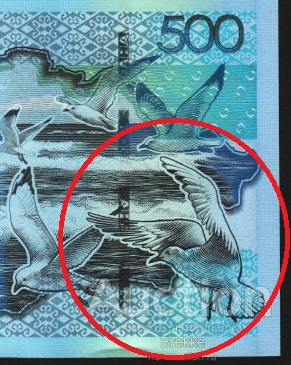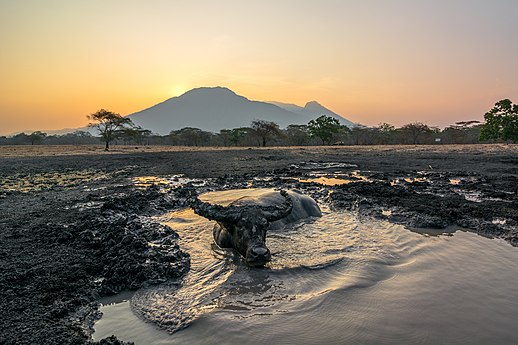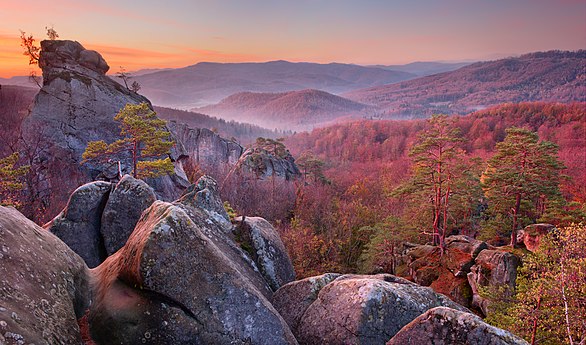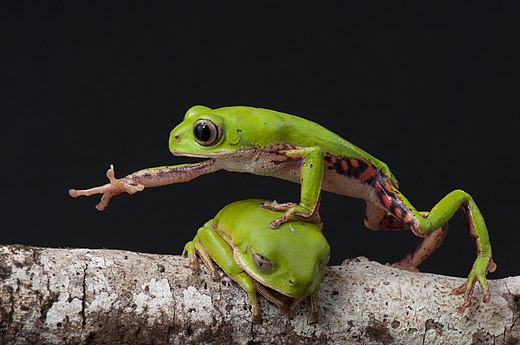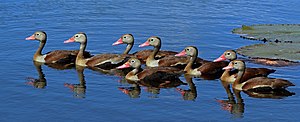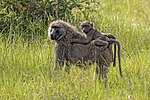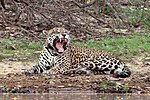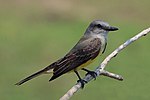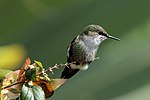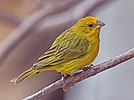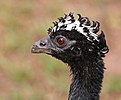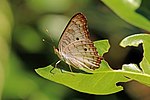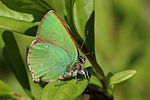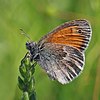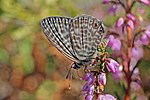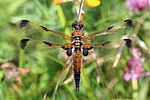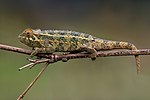Wikipedia:Wikipedia Signpost/Single/2017-12-18
Women in Red World Contest wrap-up
The Women in Red World Contest closed on 30 November at midnight. The editors working on the project created 2,885 articles in just 30 days, writing articles about notable women from every single country in the world. The contest, which began on 1 November 2017 and ran for the month had editors competing for a total of around $4,585 in prizes. The final scoreboard shows the magnitude of the editors' combined efforts: seven editors wrote more than 100 new biographical articles each in November; at least 22 editors wrote more than 30, or more than one per day on average. And all the newly-minted articles had to meet the contest's basic quality rules, for minimum size and proper references. Furthermore, a record 22 editors became members of WikiProject Women in Red during the course of the contest. Of the Did You Know's in November, twenty-nine were about articles created in the contest, as well as fifteen in December, and twenty-five that have yet to be listed .
|
The contest took a while to organize after Dr. Blofeld's proposal came to life. Besides all the heavy lifting of getting the grant approved, creating all the sign up sheets, adding multiple red links and monitoring, he used his networks to get it off the ground. Rosie Stephenson-Goodknight and Ian Pigott were instrumental in helping prepare templates, invitations, and distribution lists. Emilio wrote the bot after several months of trying to find a coder. Sue Barnum designed the logo and did much work developing the missing article lists, along with numerous other volunteers. During the contest, several judges, particularly Cwmhiraeth, verified bot findings and checked for copyvio issues and other policy-based criteria.
Interview
The Signpost's Eddie891 asked Dr. Blofeld to reflect on the contest:
- How do you feel about the number and quality of articles created during the contest?
- At the beginning of the contest I set the target of 2000. It quickly became apparent that we might end up with nearer 2500, but the end result of 2900 articles far exceeded expectations and was a brilliant result. I thought even 2000 initially was an achievement as the African Destubathon lasted six weeks and produced 2041 articles and stubs require less work than if they didn't exist. I think the overall quality of articles was very good, very few shorter stubs and the referencing mechanism I think ensured that a lot of the work produced was consistently formatted.
- If you could run the contest again, what (if anything) would you do differently?
- Very little as I think the contest proved to be a great model for development, but I had some complaints about the bot picking on formatting, so maybe I would relax some of the rules on how sources are formatted as some people did say that it demotivated them.
- What would you say is the greatest success of the contest?
- Definitely the way it worked to produce articles on every country and entity on the planet, and a wide range of occupations. While the figure of nearly 2900 was very impressive and beat records for output in one month I think the diversity displayed was extraordinary and how I think Wikipedia should be developed.
- What's next for you?
- I have a toolkit to make based on the contest to allow other editors to replicate it and run for smaller regions, I also have to take care of the prizes once I am wired the grant money and then likely propose something new early next year.
- Anything else you'd like to add?
- Thankyou everybody who contributed to the contest, and you taking the time to arrange these questions!♦ Dr. Blofeld
Editor experiences
- "My favorite article of the 52 I created for the contest? I enjoyed a lot of them," editor Penny Richards commented. "I was excited to start an article about a mapmaker, Laura L. Whitlock, because I used to study women and maps, and because her map of 1911 Los Angeles is really detailed and interesting." Richards wrote her first 26 articles for the contest in alphabetical order, one for each letter, from Asako Hirooka to Zelia Peet Ruebhausen. "That was just a fun extra challenge for myself," she explained.
- The contest inspired editor Sue Barnum to explore writing about women from Oceania. She also wrote several articles that were missing from the Singapore Women's Hall of Fame page. Her favorite article, though, was Lydia Avery Coonley. "I was finally able to write about one of the missing women from the Chicago Women's Club page. I knew she was notable, but I'd had a hard time finding sources until I searched under her second married name. Women's articles are often a challenge because women more often change their name than men!"
- Editor Ser Amantio di Nicolao turned his focus largely towards women of Central Asia. "I was stunned," he says, "by the lack of focus on the topic – the category Category:Tajikistani actresses didn't even exist at the beginning of November. I was lucky enough to find some good sources to help me begin to flesh out content. By the end of the month I'd written about around 60 new articles covering Tajikistan, Turkmenistan, Uzbekistan, and Kyrgyzstan."
- Noswall59 started off adding biographies of British academics and public servants, but ended up trying to create articles for more obscure locations that still lacked entries in the competition. "It was great to collaborate with others and strike off countries from the list. I was amazed by how patchy Wikipedia's coverage was, and enjoyed the challenge of researching new subjects. My highlights were putting together articles for women from Sark – a tiny, self-governing island in the English Channel – and the remote island of Tristan da Cunha. The competition really opened my eyes to how much still needs to be done in some parts of the world."
- The goal of editor SusunW was to add quality articles for the Caribbean, writing one article for each country on the Latin America/Caribbean missing article page. Quantity wasn't as important as making sure the articles met notability standards with adequate documentation. When she completed the goal before the month was over, she expanded her coverage to include Antarctica, Canada, Greenland and the United States, so that she had written one for each country in the Americas. She wrote, "I was really surprised to find adequate sources to include notable women from tiny Saba and Saint Pierre and Miquelon. But, my favorite articles were the group of them on mixed-race, free women planters from the 17th to 19th centuries." She'd like to see similar contests in the future with the prizes shared between participants and Women in Red, to enable the project to access paid databases or buy shared resources.
- Editor Darreg from Nigeria saw the contest as an opportunity to get the necessary motivation to reduce the knowledge gap around African contents on Wikipedia. He stated: "when so many editors are working together towards a common goal, it tends to steam me up towards that stated objective. I am happy I was able to ensure articles exist for all the female ministers in the cabinet of President Buhari. My best additions were covering topics on women pacesetters, entertainers, feminists and professors across at least eight African countries." He concluded: "I hope to see more of this on Wikipedia. I was very glad with the diversity of the results".
- Editor Alanna the Brave was inspired by the biographical histories she researched and wrote about for the contest: "I'm well aware of the gender gap in the coverage of history, both on and off Wikipedia, so it was an easy choice for me to decide to sign up for the World Contest. Over the course of the month, however, I was surprised and uplifted by the multitude of extraordinary women I stumbled across in my research. I came across stories of pioneering female aviators, broadcasters, lawyers, sea captains, explorers, poets and more. It was a wonderful reminder that women have always played a dynamic role in world history – we just need to open our eyes and look for them."
- Editor Alafarge took the contest as an opportunity to translate pages from the French and German Wikipedias, where many remarkable women lurk who are not (yet) in the English Wikipedia. Favorite find of the month: Louise von Panhuys, an early 19th century botanical artist whose work on the flora of Suriname was inspired by Maria Sibylla Merian.
- Editor The C of E focused on women's rugby union and association football articles but also branched out to other areas including politics and law. "My favourite article was the one I did on Helene Bechstein, Hitler's etiquette tutor. In carrying out my work on sports articles, I noticed that there is a gender bias against female sportswomen in terms of the sports notability guidelines where some that apply to men don't apply to women. I also tried to get my articles on DYK too but a lack of time prevented all my articles featuring."
- Miyagawa worked on a range of topics, including Paralympians and women who work in professional kitchens. "This inspired me to continue working in similar fields, to create a comprehensive list article of every female chef who has ever held a Michelin star. It'll be the first time this has been gathered anywhere, and will show a list of red linked women for future creation."
- Sturmvogel_66 focused on women whose stories were found in sources readily to hand, which primarily included scientists and physicians, Chinese nuns, East European and Balkan feminists, and American economists and historians. "Having majored in psychology and history in college, my favorite article was Tamara Dembo, who helped to pioneer psychological field theory and rehabilitation psychology in the 1930s and 1940s. The (few) economists were probably the hardest for me to write as I struggled to translate economic jargon into terms understandable by laypeople and lacked the background to understand exactly why their work was important."
- Vami_IV, who normally works in Southwestern Germany, focused almost purely on Latin American women, as the topic was interesting to him and he had prior experience with Spanish, which was not too difficult to translate with the right tools. Over the month, he translated over one hundred articles and placed third in the competition overall. "It's hard to choose a favorite," Vami writes, "but if I chose one that really stood out to me, it would be Miroslava Breach. I really bled writing that one." Even as he ran against Sturmvogel and Miyagawa, among others, Vami also competed against a spell of depression. "I'm proud to have served the women of Latin America in such a fashion" he wrote on December 6 on his Twitter. "I really like Latin America. I hope to be back soon. I hear Buenos Aires is pretty great."
Astronaut is first to specifically contribute to Wikipedia from space
For the first time, content specifically for Wikipedia has been made in space, aboard the International Space Station. Andy Mabbett explains how this came to happen.
Astronaut Paolo Nespoli recently recorded his spoken voice for use on his Wikipedia article—a small step for him, but a giant leap for the Wikimedia movement. This milestone is the first time content has been made in space specifically for Wikipedia.
Paolo, a European Space Agency (ESA) astronaut, made the recording while orbiting Earth aboard the International Space Station (ISS) for the Italian Space Agency mission VITA.
How did an astronaut contribute to Wikipedia while traveling through space at an average speed of 27,724 kilometres per hour (17,227 mph)? That involves the collaborative handiwork of several people back here on Earth.
In July this year, I approached Marco Trovatello (User:mtrova), Communication Officer with ESA's European Astronaut Centre, after seeing his excellent efforts to have ESA media released under open licence. I asked him to work with me on a recording made on the ISS. Marco jumped at the idea, and immediately agreed to help. As you can imagine, astronauts have busy schedules, but Marco was able to make all the necessary arrangements, working with his ESA colleagues to get the recording scheduled and the files transferred back to Earth (two of them: one in English, the other in Paolo's native Italian). He then uploaded them to Wikimedia Commons, where they are now available for anyone to use, freely, under an open licence (CC BY-SA 3.0 IGO), as well as being used on Wikipedia and Wikidata.

In space, no one can hear you scream… but now everyone can hear your voice
Why is it important for Paolo—and others—to record their voices for Wikipedia and its sister projects? It helps us learn the canonical pronunciation of someone's name. (I know that in my own family, different branches pronounce "Mabbett" differently). Asking our subjects to say a few more words besides their name also gives a fuller impression of what their voice sounds like, and that helps our readers to recognise them, for example, if they hear them on the radio.
The project was conceived at Wikimedia meetup in London in 2012. I suggested that we ought to include people's voices on Wikipedia, and on the train home worked up some ideas, which I put into a blog post. I then contacted everyone I knew who had had a Wikipedia article written about them, and some kindly made recordings to get things started.
Since then, a small group of volunteers, including myself, have worked with many article subjects to add hundreds of recordings in 24 languages. They feature actors, sportspeople, Nobel-laureate scientists, authors, Eurovision Song Contest contestants, Wikimedians, and even another astronaut—Charlie Duke of NASA, who once walked on the moon, though his recording was made on Earth. I even persuaded the BBC to donate hundreds of clips from their radio programmes. It was the first time BBC content had been released under an open licence.
But we still need lots more recordings, in lots more languages—and you can help with this. Ask anyone you know who has a Wikipedia article (or a Wikidata item) to make a recording as set out on the project page. Most recordings run from 10–20 seconds, which is not a lot to ask of even very busy people. You can record them on a mobile phone, but do try to find somewhere quiet to cut down on background noise.
Who knows, maybe someone in space will listen to your recording.
- Andy Mabbett (User:Pigsonthewing), Wikimedian
This piece originally appeared at the Wikimedia Blog, where it is also available in Italian.
Featured content to finish 2017
Featured articles
17 featured articles were promoted this month.
- Scarlett Johansson (nominated by FrB.TG) is an American actress and singer. She was among the world's highest-paid actresses from 2014 to 2016, has made multiple appearances in the Forbes Celebrity 100, and has a star on the Hollywood Walk of Fame. She has acted in numerous movies, and was nominated for four Golden Globe Awards. In addition, Johansson has been on Broadway and won a Tony Award for Best Featured Actress. She was the highest-grossing actress of 2016, and is also, as of May 2017, the highest-grossing actress of all time in North America. As a public figure, Johansson is considered a modern sex symbol of Hollywood. She is a prominent celebrity brand endorser, and also supports various charities and causes. She has been married twice, first to Canadian actor Ryan Reynolds from 2008 to 2011 and later to French businessman Romain Dauriac (with whom she has a daughter) from 2014 to 2017.
- Friedrich Wilhelm von Seydlitz (nominated by Auntieruth55) was a Prussian lieutenant general, and among the greatest of the Prussian cavalry generals. He commanded one of the first Hussar squadrons of Frederick the Great's army and is credited with the development of the Prussian cavalry to its efficient level of performance in the Seven Years' War. Seydlitz became legendary throughout the Prussian Army both for his leadership and for his reckless courage. During the Seven Years' War, he came into his own as a cavalry general, known for his coup d'œil, his ability to assess at a glance the entire battlefield situation and to understand intuitively what needed to be done: he excelled at converting the King's directives into flexible tactics. In the war, he played a key role in several battles. Frederick rewarded him with the Order of the Black Eagle on the field after the Battle of Rossbach; he had already received the Pour le Mérite for his action at the Battle of Kolin. Although estranged from Frederick for several years, the two were reconciled during Seydlitz's final illness. Seydlitz died in 1773, and Frederick's heirs included his name on the Equestrian statue of Frederick the Great in Berlin, in a place of honor.
- Lilias Armstrong (nominated by Umimmak) was an English phonetician. Her book on English intonation, written with Ida C. Ward, was in print for fifty years. She also provided some of the first detailed descriptions of tone in Somali and Kikuyu. Armstrong grew up in Northern England. She graduated from the University of Leeds, where she studied French and Latin. She taught French in an elementary school in the London suburbs before joining the University College Phonetics Department, headed by Daniel Jones, where she was eventually appointed as a reader. Her works include the 1926 book A Handbook of English Intonation (co-written with Ward), the 1934 paper "The Phonetic Structure of Somali", and the book The Phonetic and Tonal Structure of Kikuyu, published posthumously in 1940. She was the subeditor of the International Phonetic Association's journal Le Maître Phonétique for more than a decade, and was praised in her day for her teaching. Jones wrote in his obituary of her that she was "one of the finest phoneticians in the world".
- Saguaro National Park (nominated by Finetooth) is a United States national park in Pima County in southeastern Arizona. The 92,000-acre (37,000 ha) park consists of two separate areas—the Tucson Mountain District (TMD) about 10 miles (16 km) west of the city of Tucson and the Rincon Mountain District (RMD) about 10 miles (16 km) east of the city—that preserve Sonoran Desert landscapes, fauna, and flora, including the giant saguaro cactus. Earlier residents of and visitors to the lands in and around the park before its creation included the Hohokam, Sobaipuri, Tohono O'odham, Apaches, Spanish explorers, missionaries, miners, homesteaders, and ranchers. In 1933, President Herbert Hoover, using the power of the Antiquities Act, established the original park, Saguaro National Monument, in the Rincon Mountains. In 1961, President John F. Kennedy added the Tucson Mountain District to the monument and renamed the original tract the Rincon Mountain District. Congress combined the TMD and the RMD to form the national park in 1994. Popular activities in the park include hiking on its 165 miles (266 km) of trails and sightseeing along paved roads near its two visitor centers. Both districts allow bicycling and horseback riding on selected roads and trails. The RMD offers limited wilderness camping, but there is no overnight camping in the TMD.
- Patrick Henry (nominated by Wehwalt) was an American attorney, planter, and orator well known for his declaration to the Second Virginia Convention (1775): "Give me liberty, or give me death!" A Founding Father, he served as the first and sixth post-colonial Governor of Virginia, from 1776 to 1779 and from 1784 to 1786. Henry became a lawyer, who soon won Parson's Cause against the Anglican clergy. A member of the Virginia House of Burgesses, he crusaded against the Stamp Act of 1765. Henry was a delegate to First and Second Continental Congresses. He gained further popularity among the people of Virginia, both through his oratory at the convention and by marching troops towards the colonial capital of Williamsburg after the Gunpowder Incident until the munitions seized by the royal government were paid for. A prominent supporter of independence, he helped draft the Virginia Declaration of Rights and the original Virginia Constitution. Henry was promptly elected governor under the new charter. After leaving the governorship in 1779, Henry served in the Virginia House of Delegates and was later reelected governor. The actions of the national government under the Articles of Confederation made Henry fear a strong federal government, and he actively opposed the ratification of the Constitution, a fight which has marred his historical image. A slaveholder throughout his adult life, he hoped to see the institution end, but had no plan for that beyond ending the importation of slaves. Henry is remembered for his oratory, and as an enthusiastic promoter of the fight for independence.
- SMS Wittelsbach (nominated by Parsecboy) was the lead ship of her class of pre-dreadnought battleships, built for the German Imperial Navy. She was the first capital ship built under the Navy Law of 1898 that was brought about by Admiral Alfred von Tirpitz. Wittelsbach was laid down in 1899 at the Wilhelmshaven Navy Dockyard and completed in October 1902, armed with a main battery of four 24 cm (9.4 in) guns and with a top speed of 18 knots (33 km/h; 21 mph). During World War I the ship served in the IV Battle Squadron, with limited non-combat duty in the Baltic Sea, including during the Battle of the Gulf of Riga in August 1915. By late 1915, crew shortages and the threat from British submarines forced the navy to withdraw older battleships like Wittelsbach. The ship then saw service in auxiliary roles, first as a training ship and then as a ship's tender. After the war, she was converted into a tender for minesweepers in 1919.
- Saint Fin Barre's Cathedral (nominated by Ceoil () is a Gothic revival three spire cathedral in the city of Cork, Ireland. It belongs to the Church of Ireland and was completed in 1879. Christian use of the site dates back to a seventh-century monastery, and was, according to tradition, founded by Finbarr of Cork. During the medieval period, the site underwent successive wars, waves of church building and damage. Around 1536, during the Protestant Reformation, the cathedral became part of the Established Church. After a previous building was destroyed, work began in 1863, and resulted in the first major commission for the Victorian architect William Burges, who designed most of Fin Barre's architecture, sculpture, stained glass, mosaics and interior furniture. Saint Fin Barre's foundation stone was laid in 1865. The cathedral was consecrated in 1870, and the limestone spires completed by October 1879.
- The black honeyeater (nominated by Cas Liber) is a species of bird in the honeyeater family Meliphagidae, and the sole species in the genus Sugomel. The black honeyeater exhibits sexual dimorphism, with the male being black and white while the female is a speckled grey brown; immature birds look like the female. The species is endemic to Australia, and ranges widely across the arid areas of the continent, through open woodland and shrubland, particularly in areas where the emu bush and related species occur. A nectar feeder, the black honeyeater has a long curved bill to reach the base of tubular flowers such as those of the emu bush. It also takes insects in the air, and regularly eats ash left behind at campfires. Cup-shaped nests are built in the forks of small trees or shrubs. The male engages in a soaring song flight in the mating season, but contributes little to nest building or incubating the clutch of two to three eggs. Both sexes feed and care for the young. While the population appears to be decreasing, the black honeyeater is sufficiently numerous and widespread to be considered least concern on the International Union for Conservation of Nature (IUCN)'s Red List of Endangered species.
- Lady Gaga (nominated by FrB.TG) is an American singer, songwriter, and actress. She is known for her unconventionality and provocative work as well as experimenting with new images. Having sold 27 million albums and 146 million singles as of January 2016, Gaga is one of the best-selling music artists of all time. Her achievements include several Guinness World Records, three Brit Awards, six Grammy Awards, and awards from the Songwriters Hall of Fame and the Council of Fashion Designers of America. Gaga has been declared Billboard's Artist of the Year and included among Forbes's power and earnings rankings. She was ranked at number four on VH1's Greatest Women in Music in 2012, finished second on Time's 2011 readers' poll of the most influential people of the past ten years, and was named Billboard's Woman of the Year in 2015. She is known for her philanthropic work and social activism, including LGBT rights, and for her non-profit organization, the Born This Way Foundation, which focuses on promoting youth empowerment and combating bullying.
- The Bat (play) (nominated by RL0919) is a three-act play by Mary Roberts Rinehart and Avery Hopwood that was first produced by Lincoln Wagenhals and Collin Kemper in 1920. The story combines elements of mystery and comedy as Cornelia Van Gorder and guests at her rented summer home spend a stormy night searching for stolen money they believe is hidden in the house, while they are stalked by a masked criminal known as "the Bat". The Bat's identity is revealed at the end of the final act. After opening in 1920, The Bat was a critical and commercial success. It ran for 867 performances in New York and 327 performances in London; several road companies took the show to other areas. The play was revived twice on Broadway, in 1937 and 1953. It had several adaptations, including a 1926 novelization credited to Rinehart and Hopwood but ghostwritten by Stephen Vincent Benét. Three film adaptations were produced: The Bat (1926), The Bat Whispers (1930), and The Bat (1959). The play and its adaptations inspired other comedy-mysteries with similar settings, and influenced the creation of the comic-book superhero Batman.
- John Tyndall (politician) (nominated by Midnightblueowl) was a British fascist political activist. A leading member of various small neo-Nazi groups during the late 1950s and 1960s, he was chairman of the National Front from 1972 to 1974 and again from 1975 to 1980, and then chairman of the British National Party from 1982 to 1999. He unsuccessfully stood for election to the House of Commons and European Parliament on several occasions.
- Elizabeth David (nominated by Tim riley & SchroCat) was a British cookery writer. In the mid-20th century she strongly influenced the revitalisation of home cookery in her native country and beyond with articles and books about European cuisines and traditional British dishes. In the 1930s she studied art in Paris, became an actress, and ran off with a married man with whom she sailed in a small boat to Italy, where their boat was confiscated. They reached Greece, where they were nearly trapped by the German invasion in 1941, but escaped to Egypt, where they parted. She then worked for the British government, running a library in Cairo. While there she married, but she and her husband separated soon after and subsequently divorced. In 1946 David returned to England, where food rationing imposed during the Second World War remained in force. Dismayed by the contrast between the bad food served in Britain and the simple, excellent food to which she had become used in France, Greece and Egypt, she began to write magazine articles about Mediterranean cooking. They attracted favourable attention, and in 1950, at the age of 36, she published A Book of Mediterranean Food. Her recipes called for ingredients such as aubergines, basil, figs, garlic, olive oil and saffron, which at the time were scarcely available in Britain. Books on French, Italian and, later, English cuisine followed. By the 1960s David was a major influence on British cooking. She was deeply hostile to anything second-rate, and to over-elaborate cooking and bogus substitutes for classic dishes and ingredients. In 1965 she opened a shop selling kitchen equipment, which continued to trade under her name after she left it in 1973. David's reputation rests on her articles and books, which have been continually reprinted. Between 1950 and 1984 she published eight books; after her death her literary executor completed a further four that she had planned and worked on. David's influence on British cooking extended to professional as well as domestic cooks, and chefs and restaurateurs of later generations such as Terence Conran, Simon Hopkinson, Prue Leith, Jamie Oliver, Tom Parker Bowles and Rick Stein have acknowledged her importance to them. In the U.S., cooks and writers including Julia Child, Richard Olney and Alice Waters have written of her influence.
- Der 100. Psalm (nominated by Gerda Arendt) is a composition in four movements by Max Reger in D major for mixed choir and orchestra, a late Romantic setting of Psalm 100. Reger began composing the work in 1908 for the 350th anniversary of Jena University. The occasion was celebrated that year with the premiere of Part I, conducted by Fritz Stein on 31 July. Reger completed the composition in 1909. It was published that year and premiered simultaneously on 23 February 1910 in Chemnitz, conducted by the composer, and in Breslau, conducted by Georg Dohrn. Reger structured the text in four movements, as a choral symphony. He scored it for a four-part choir with often divided voices, a large symphony orchestra, and organ. He requested additional brass players for the climax in the last movement when four trumpets and four trombones play the melody of Luther's chorale "Ein feste Burg ist unser Gott". Reger used both late-Romantic features of harmony and dynamics, and polyphony in the Baroque tradition, culminating in the final movement, a double fugue with the added instrumental cantus firmus.In 1922, the biographer Eugen Segnitz noted that this work, of intense expression, was unique in the sacred music of its period, with its convincing musical interpretation of the biblical text and manifold shades of emotion. Paul Hindemith wrote a trimmed adaption which probably helped to keep the work in the repertory, and François Callebout wrote an organ version, making the work accessible for smaller choirs. The organ version was first performed in 2003, in Wiesbaden where the composer studied. The celebration of the Reger Year 2016, reflecting the centenary of the composer's death, led to several performances of Der 100. Psalm.
- Megalodon (nominated by User:Dunkleosteus77) meaning "big tooth", is an extinct species of shark that lived approximately 23 to 2.6 million years ago (mya), from the Early Miocene to the end of the Pliocene. The shark has made appearances in several media, such as the Discovery Channel's docufiction Megalodon: The Monster Shark Lives. Scientists suggest that megalodon looked like a stockier version of the great white shark, though it may have looked similar to the basking shark (Cetorhinus maximus) or the sand tiger shark (Carcharias taurus). Regarded as one of the largest and most powerful fish to have ever lived, fossil remains of megalodon suggest that this giant shark reached a length of 18 meters (59 ft), though there are many other competing figures due to fragmentary remains; for example, 24 to 25 meters (79 to 82 ft). Their large jaws could exert a bite force of up to 110,000 to 180,000 newtons (25,000 to 40,000 lbf). Their teeth were thick and robust, built for grabbing prey and breaking bone. Megalodon probably had a profound impact on the structure of marine communities. The fossil record indicates that it had a cosmopolitan distribution. Megladon would have fed on large sea animals. The animal faced competition from whale-eating cetaceans, such as Livyatan and ancient killer whales (Orcinus citoniensis), which likely contributed to its extinction. As it preferred warmer waters, it is thought that oceanic cooling associated with the onset of the ice ages, coupled with the lowering of sea levels and resulting loss of suitable nursery areas, may have also contributed to its decline. A reduction in the diversity of baleen whales and a shift in their distribution toward polar regions may have reduced megalodon's primary food source. The extinction of the shark appeared to affect other animals; for example, the size of baleen whales increased significantly after the shark had disappeared.
- HMS Neptune (1909) (nominated by Sturmvogel 66) was a dreadnought battleship built for the Royal Navy in the first decade of the 20th century, the sole ship of her class. She was the first British battleship to be built with superfiring guns. Shortly after her completion in 1911, she carried out trials of an experimental fire-control director and then became the flagship of the Home Fleet. Neptune became a private ship in early 1914 and was assigned to the 1st Battle Squadron. The ship became part of the Grand Fleet when it was formed shortly after the beginning of the First World War in August 1914. Aside from participating in the Battle of Jutland in May 1916, and the inconclusive Action of 19 August several months later, her service during the war generally consisted of routine patrols and training in the North Sea. Neptune was deemed obsolete after the war and was reduced to reserve before being sold for scrap in 1922 and subsequently broken up.
- History of the British farthing (nominated by Wehwalt): The British farthing was a British coin worth a quarter of an old penny ( 1⁄960 of a pound sterling). It ceased to be struck after 1956 and was demonetised from 1 January 1961. The British farthing is a continuation of the English farthing. Only pattern farthings were struck under Queen Anne as there was a glut of farthings from previous reigns. The coin was struck intermittently under George I and George II, but by the reign of George III, counterfeits were so prevalent the Royal Mint ceased striking copper coinage after 1775. The next farthings were the first struck by steam power, in 1799 by Matthew Boulton at his Soho Mint under licence. Boulton coined more in 1806, and the Royal Mint resumed production in 1821. The farthing was struck fairly regularly under George IV and William IV. By then it carried a scaled-down version of the penny's design, and would continue to mirror the penny and halfpenny until after 1936. Farthings were struck in most years of Queen Victoria's long reign. The coin continued to be issued in most years of the first half of the 20th century, and in 1937 it finally received its own reverse design, a wren. By the time the coin bore the portrait of Elizabeth II in 1953–1956, inflation had eroded its value. A fall in commercial demand also contributed to its demise.
- The Three Sisters (Oregon) (nominated by ceranthor) are volcanic peaks that form a complex volcano in the U.S. state of Oregon. They are part of the Cascade Volcanic Arc, a segment of the Cascade Range in western North America. More than 10,000 feet (3,000 m) in elevation, they are the third-, fourth-, and fifth-highest peaks in Oregon. Located in the Three Sisters Wilderness, they are about 10 miles (16 km) south of the nearest town, Sisters. The mountains, particularly South Sister, are popular destinations for climbing and scrambling. They are subject to frequent snowfall, occasional rain, and extreme temperature variation between seasons. Although they are often grouped together as one unit, the three mountains differ in geology and eruptive history. Neither North Sister nor Middle Sister has erupted in the last 14,000 years. South Sister last erupted about 2,000 years ago and might erupt in the future, threatening life within the region. After satellite imagery detected tectonic uplift near South Sister in 2000, the United States Geological Survey improved monitoring in the immediate area.
Featured lists
28 featured lists were promoted this month.
- Grade II* listed buildings in Taunton Deane (nominated by Rodw)
- List of 3D Realms games (nominated by PresN)
- List of Sites of Special Scientific Interest in Suffolk (nominated by Dudley Miles)
- List of World Heritage Sites in Croatia (nominated by Tone)
- List of Sites of Special Scientific Interest in Suffolk (nominated by Dudley Miles)
- List of World Heritage Sites in Croatia (nominated by Tone)
- Laureus Lifetime Achievement Award (nominated by The Rambling Man)
- List of five-wicket hauls in women's One Day International cricket (nominated by Ianblair23)
- National Film Award for Best Supporting Actress (nominated by Yashthepunisher)
- Territorial evolution of the United States (nominated by Golbez)
- List of songs recorded by Syd Barrett (nominated by BeatlesLedTV)
- Segrave Trophy (nominated by The Rambling Man)
- Michelle Williams on screen and stage (nominated by Krimuk2.0)
- Mark Romanek videography (nominated by Damian Vo)
- List of Sites of Special Scientific Interest in Rutland (nominated by Dudley Miles)
- List of Falcon 9 and Falcon Heavy launches (nominated by Insertcleverphrasehere)
- List of best-selling Latin albums in the United States (nominated by Magiciandude)
- List of accolades received by The Tree of Life (film) (nominated by Ssven2)
- Laureus World Sports Award for Team of the Year (nominated by The Rambling Man)
- Laureus World Sports Award for Sportsperson of the Year with a Disability (nominated by Harrias)
- Laureus World Sports Award for Comeback of the Year (nominated by The Rambling Man)
- India women's national cricket team record by opponent (nominated by Vensatry)
- Grade II* listed buildings in West Somerset (nominated by Rodw)
- Cardiff City F.C. league record by opponent (nominated by Kosack)
- Associated Press NFL Defensive Player of the Year Award (nominated by Lizard the Wizard)
- World Rugby Player of the Year (nominated by The Rambling Man)
- Suffolk Wildlife Trust (nominated by Dudley Miles)
- List of accolades received by Moneyball (film) (nominated by Ssven2)
Featured pictures
Three featured pictures were promoted this month.
-
Electrical cable 3×2.5 mm
(created and nominated by Petar Milošević) -
Castillo de San Juan Bautista, in the city of Santa Cruz de Tenerife in the Canary Islands of Spain, was the second most important fort in the defense of Santa Cruz de Tenerife.
(created and nominated by Der Wolf im Wald)
Featured topics
One featured topic was promoted since our last report.

Stolen seagulls, public domain primates and more
When Kazakhstan released a brand new 500 tenge bill (about US$1.50), a Swiss photographer named Marcel Burkhard noticed something odd about the bird on the face of the bill. It looked exactly like the bird that he had uploaded to Wikipedia on December 3, 2005, as User:Cele4. The photo is the lead image at ru:Чайковые and that photo is alleged to have been lifted by the Kazakhstan Central Bank and placed on their bill. The bank has denied all accusations of plagiarism, but has announced that they would change the bill "in time".
The bird is just one of the many times that Wikipedia content has been plagiarized (see previous Signpost coverage). People from editors at BuzzFeed, to an American senator, to the Pentagon, to Oxford University Press have all lifted content from Wikipedia. (Global Voices)
Interview with the monkey selfie photographer
Podcast This American Life presented "So a Monkey and a Horse Walk Into a Bar" featuring a narrative of how Wikimedia projects have presented the monkey selfie copyright dispute along with a conversation with photographer David Slater. Persons interested in the issue can read past coverage in The Signpost. At least hundreds and perhaps a few thousand Wikimedia community members engaged in conversation about the monkey selfie dispute in 2014 or later. Because of the controversy around this issue, this commentator at The Signpost will speak only for themselves in making the following observations about what is striking about this podcast:
- The Wikimedia community is sensitive to distinguishing the differences between online media platforms, the community which publishes on that platform, and the organization which hosts it. Wikimedia community members observe that mainstream media seems to understand that for example, Facebook the website is different from individual users who post to Facebook, and that Facebook as a company is different still. This podcast like many other mainstream media reports of Wikipedia conflates and confuses Wikipedia the platform, the community of users which publishes to Wikimedia projects, and the Wikimedia Foundation as an organization. It is unfortunate that Slater, even since 2014 and all that he has experienced, seems to express no awareness of the basics of how Wikipedia works and what distinctions exist between the publication, editors, and paid Foundation staff. This American Life journalists seem similarly confused. How can the Wikimedia movement better present itself to avoid this sort of confusion?
- Whatever happened in this case, many people respect This American Life as a podcast and yet somehow their journalistic investigation described Wikimedia projects in a way which community participants would probably regard as flawed in its premises. For example, the podcast reports that the Wikimedia Foundation exercises editorial control over Wikipedia's content.
- Slater is obviously highly distraught and feels that "Wikipedia" (whether platform, community, or WMF) has greatly harmed him. While sometimes the Wikimedia community may conflict with others, ideally, the conflict could proceed with the Wikimedia community's sincere attempt to establish mutual understanding and some transparent documentation that we offered a fair process.
- In Wikimedia community lore, the Wikimedia community imagined that on December 22, 2014, in section 313.2 the United States Copyright Office provided clarification on the monkey selfie dispute when it published the below statement. The podcast did not mention if the photographer or anyone else was aware that the Copyright Office had recently published an opinion on monkey photography.
| “ | The Office will not register works produced by nature, animals, or plants. ... Examples: A photograph taken by a monkey. | ” |
| — https://www.copyright.gov/comp3/docs/compendium.pdf | ||
In brief
- Jerusalem After Trump Move, Jerusalem Battle Now Plays Out on Wikipedia, Haaretz
- Wikipedia less corrupting than leading social media: The Economist reports that whereas bad actors have gamed leading social media platforms into popularizing misinformation, Wikipedia is "reasonably clean, honest and reliable".
- Wikipedia editors are sometimes out of this world: GoodNewsNetwork reported that the first piece of content created specifically for Wikipedia in space occurred when astronaut Paolo Nespoli contributed a recording of him pronouncing his name. For more information, see additional Signpost coverage.
- The Intercept reports in a December 1 story that Koch brothers have been employing a PR firm, New Media Strategies, owned by Meredith Corporation, to wikiwash articles related to themselves.
- Everipedia: Everipedia, one of the many competitors of Wikipedia, has tapped Larry Sanger as their new CIO. Sanger plans to make Everipedia the largest 'pedia by using blockchain, something that has never been done before. Wired reported that Sanger intends to turn 'points' that users gain from editing into virtual tokens, that will give users a financial stake in Everipedia.
- No protest over net neutrality: Sites like Salon (December 3), Tom's Hardware (December 12), and USA Today's northjersey.com (November 22) cited Wikipedia's 2015 SOPA-protest blackout in their coverage of the Federal Communications Commission's U.S. net neutrality rules change, including a proposed similar "Break the Internet" event. No such Wikipedia blackout occurred this year, and the Commission rolled back the rule on December 14. A Village Pump proposal that had begun on December 7 (permlink) was declared moot on December 15.
Last case of 2017: Mister Wiki editors
This edition of the Arbitration Report covers 24 November through 15 December 2017.
Conduct of Mister Wiki editors case
On 21 November 2017, the request for the case concerning Mister Wiki editors was opened by TonyBallioni – as reported in Signpost issue 11 News and Notes.
On 1 December, Wikipedia:Arbitration/Requests/Case/Conduct of Mister Wiki editors was formally opened. According to the first arb to accept the case, it is "to review whether a desysop is in order for Salvidrim". Arbcom has stated that if the case isn't decided by the end of December – when some of the standing arbs will be replaced due to 2017 elections – "outgoing Arbs will be able to remain active on it if they wish, and incoming arbs will be able to join it if they wish." Points considered by Arbitration Committee include:
- The alleged breach of WP:PAY by Salvidrim! and Soetermans in reviewing each other's AfC submissions.
- Salvidrim!'s use of admin tools to grant additional userrights to the account Salvidrim! (paid).
- Any other evidence relevant to conflicts of interest by editors associated with the Mister Wiki business
An Arbcom member stated "we do not have Committee support for a case on paid editing per se - that is appropriately a matter for the community. What there is support for, is whether specific named editors have acted outside of policies on meatpuppetry and COI, in their role as paid editors on this site".
Interested editors can still comment at the case's workshop through 22 December. The case page states that a decision will be posted by 29 December.
Current requests
- Clarification request: Palestine-Israel articles was opened 1 December to clarify when the "24 hour timer" for discretionary sanctions starts.
Declined requests
- Crosswiki issues request: The request for a case was declined with a motion (permlink) for an RfC to decide "Whether and how information from Wikidata should be used on English Wikipedia...who should decide whether and when Wikidata content should be included, the standards to be used in making those decisions, and the proper role, if any, of the Wikimedia Foundation (WMF) in connection with this issue". Discretionary sanctions around Wikidata integration were established and the motion mentioned "systematic Wikidata-related edits on English Wikipedia that would be difficult to reverse" as a potential trigger.
- List of current NHL captains and alternate captains request filed 4 December, declined 6 December <0/7/0>
In brief
- 2017 Arbcom elections:
At press time for this issue of Signpost, results of the 2017 Arbcom elections had not yet been announced. Extremely low turnout was noted at Jimbo's talkpage. Possible explanations offered were a voting system failure and lack of a mass message to eligible voters. Mz7 said that between 2014 and 2015 when mass messages became routine, voting went up over fourfold. At the time the conversation began in late November, fewer than 300 votes had been recorded. Mass messages were sent out on 3 December – midway through the voting period – and by the time voting closed, 1,993 valid votes were tallied.
- STOP PRESS: Results released.
| Candidate | Support | Neutral[note 1] | Oppose | Net[note 2] | Percentage[note 3] | Result |
|---|---|---|---|---|---|---|
| KrakatoaKatie | 1072 | 681 | 238 | 834 | 81.83% | Two-year term |
| Callanecc | 820 | 933 | 238 | 582 | 77.50% | Two-year term |
| Opabinia regalis | 810 | 900 | 281 | 529 | 74.24% | Two-year term |
| Worm That Turned | 751 | 924 | 316 | 435 | 70.38% | Two-year term |
| RickinBaltimore | 639 | 1053 | 299 | 340 | 68.12% | Two-year term |
| Premeditated Chaos | 593 | 1055 | 343 | 250 | 63.35% | Two-year term |
| BU Rob13 | 598 | 1009 | 384 | 214 | 60.90% | Two-year term |
| Alex Shih | 598 | 997 | 396 | 202 | 60.16% | Two-year term |
| Mailer diablo | 552 | 1038 | 401 | 151 | 57.92% | |
| SMcCandlish | 663 | 837 | 491 | 172 | 57.45% | |
| The Rambling Man | 593 | 751 | 647 | −54 | 47.82% | |
| Sir Joseph | 444 | 876 | 671 | −227 | 39.82% |
- ^ All voters were required to register a preference of either "Support", "Neutral", or "Oppose" for each candidate. The "Neutral" column is simply the total votes for which voters did not select the Support or Oppose option.
- ^ Net = Support − Oppose
- ^ Percentage = (Support / (Support + Oppose)) * 100 (rounded to 2 decimal places)
- Certified by:
Wiki loving
Wiki Loves Earth 2017 was an international photographic competition whose winner will get a full scholarship to Wikimania 2018 in Cape Town, South Africa.
Nearly 132,000 images, all freely licensed, have been added to Wikimedia Commons in the fourth annual Wiki Loves Earth. The photographic contest focuses on protected areas, unique places of natural heritage, to document them for future generations.
Wiki Loves Monuments 2017 was a similar competition focusing on cultural heritage monuments, with more than 245,000 freely licensed images submitted. Several of the winning photographs were from first-time contributors.
Wiki Loves Earth
-
Ogoy Island in Russia's Lake Baikal
Photo by Sergey Pesterev -
A jaguar in the Pantanal Conservation Area of Brazil
Photo by Leonardo Ramos -
A pair of Eurasian spoonbills in the Danube Biosphere Reserve, Ukraine
Photo by Sergey Pesterev -
A water buffalo getting a nice soak in Baluran National Park, Indonesia.
Photo by Candra Firmansyah -
Two Svalbard reindeer grazing in Bünsow Land National Park, Spitsbergen, Norway
Photo by Siri Uldal -
Pedra Azul (Blue Stone) with the Milky Way above it, located in the eponymous state park in Brazil
Photo by EduardoMSNeves -
A Bornean orangutan
Photo by Ridwan0810 -
The Dovbush rocks seen at twilight, located in the Polyanytskiy Regional Landscape Park, Ukraine
Photo by Пивовар Павл -
Aerial shot of Dzharylhach National Nature Park, Ukraine
Photo by Yunyk -
A Phyllomedusa rohdei frog steps over its friend, seen in Brazil
Photo by Renato Augusto Martins -
Railroad tracks through Lawachara National Park, Bangladesh, provide a convenient path.
Photo by Pallabkabir -
A peak in the Nilgiri Himal mountains backdrops this shot of a simple suspension bridge over the Gandaki River in Nepal.
Photo by Faj2323 -
A northern pika peeks over a rock in Momsky National Park, Russia.
Photo by Юрий Емельянов -
A recently burned-down forest on Parnitha Mountain, Greece
Photo by Stathis floros -
Capybaras near the Tietê River in São Paulo state, Brazil
Photo by Clodomiro Esteves Junior
Wiki Loves Monuments
-
The Khandoba Temple in Pune
Photo by PKharote -
The Royal pavilion in Phraya Nakhon Cave in Khao Sam Roi Yot National Park, Thailand
Photo by BerryJ -
Baitul Mukarram Mosque in Dhaka, Bangladesh
Photo by Azim Khan Ronnie -
Inner staircase of the Baron Empain Palace tower in Cairo, Egypt
Photo by Manadily -
Exterior of Verrucole Castle in Tuscany, Italy
Photo by Iris.gonelli -
Interior of Verrucole Castle in Tuscany, Italy
Photo by Simone Letari -
Baitul Mukarram Mosque in Dhaka, Bangladesh
Photo by Jubair1985 -
Notre-Dame Basilica in Montreal, Canada
Photo by Diego Delso -
Wat Benchamabophit in Bangkok, Thailand
Photo by BerryJ -
Sydney Opera House in Australia
Photo by Alphacontrol -
The derelict West Pier of Brighton, United Kingdom
Photo by Matthew Hoser -
The casino of the Kurhaus Wiesbaden
Photo by Martin Kraft -
Koshki (towers) in Mestia, Svaneti, Georgia
Photo by Dmytro Balkhovitin -
Ceiling of Tabatabaeis' House in Kashan, Iran
Photo by Mostafameraji -
Old town of Comacchio and its bridges
Photo by Francesco-1978
Interview with Charlesjsharp, regular contributor of Wikipedia's featured pictures
User:Charlesjsharp is a regular contributor of featured pictures. I spoke to him about his work and his experiences.
- How did you first come to Wikipedia?
Someone told me anyone could edit Wikipedia, so on 29 October 2006 I uploaded a few photos into articles. The one of my son skiing has remained the 'main' article image for nearly ten years. I started taking photos when I was very young, then took up wildlife photography more seriously when I retired and remarried. We both share a passion for wildlife (and travel). I set up galleries on my Commons User pages and started submitting images for Quality Image and Valued Image status. Then I learnt that someone had submitted one of the first photos I had taken with my new camera set up to be Picture of the Day in France in 2014 and English Wikipedia Featured Picture in 2015.
- Could you tell us a bit about Sharp Photography?
Maintaining my galleries on Wikipedia was quite time-consuming and with 1000+ images got too complicated, so I needed my own website. This has help me establish my reputation and also helps me find my own pictures easily! I cannot store full-size images on my website as it grinds to a halt, so I link to Flickr galleries. Having a decent website does mean I get better guides when I travel.
- What is your process of getting an image to featured picture status, and do you have any advice to people who may be new to the process?
I submit pictures for featured picture status on Commons and English Wikipedia. The Commons process is a very useful way of helping you edit and post-process your images. Most of the 'judges' do make constructive comments. English Wikipedia is more random as there are fewer judges, though the calibre of comments is just as good. Many decent nominations fail however just because they don't reach the quorum, so it's a frustrating experience. I always submit to QI and VI before going for FP. The best compositions I submit to FP. And you have to be prepared for forceful criticism. And my top tips when using Photoshop CS6? Here is my editing process for a wildlife QI with no glaring defects: 1. Rotate image 2. Improve the original composition by cropping (e.g. rule of thirds) 3. Clone out any distracting elements that don't make the image dishonest (stray leaves, twigs etc. are OK) 4. Do very gentle sharpening across the image (Unsharp Mask 1 Pixel 50%), but do bit more on faces and eyes if needed (sharp eyes crucial for FP) 5. Reduce Shadows (20-40%) and highlights (~3%) 6. Apply Autotone then Fade Autotone (sometimes 50%) 7. Try Gamma Correction (max 0.9) 8. Check Color Balance 9. Apply noise reduction across all the image (my default is 70% Strength; 70% Preserve Details 70% Reduce Color Noise 0% Sharpen) 10. Selective noise reduction on background (I use Quick Selection Tool set at 6 pixels - 3 pixels for hair). If you are new to the process, I'd suggest 1. Submit images to QI. 2. Get involved in assessing images on Commons before trying your own. 3. Then nominate an outstanding image by an established Commons photographer 4. Nominate your own best image ever. 5. Don't get upset when it gets shot down and don't get personal! Charlesjsharp (talk) 12:13, 14 October 2017 (UTC)
- What was the hardest picture for you to take/get to FP? What is your favorite picture?
I don't stake out animals and wait for hours for them to appear like many professionals. I'm more of a wildlife portrait photographer and just hope something interesting happens when my cameras ready. We were moving around a lake in Kenya in 2016 when we saw a giant kingfisher catch a fish and moved closer to the pole where it was perched. The sequence I took of the bird smashing the fish against the post to break its spine so it could swallow it was a nice bit of luck.
- What is next for you?
More countries. More wildlife. And a wildlife book is on the way too. I've also got a bunch of light-hearted animal photo-quizzes on my website www.sharpphotography.co.uk and that might go somewhere...
- Where do you see Wikipedia in the next few years?
Just getter better and better. There doesn't seem to be any serious competitor and I'm impressed by the accuracy of the articles. Wikipedia is always the first place I go for information on anything.
- Anything else you'd like to say?
Anything I don't like. I do think that too many of the active participants on the Commons FPC project are damaging the FP credibility. It seems that almost any photo can get voted through on a you-vote-for-me and I'll-vote-for-you process – no collusion, just a low quality theshold. Charlesjsharp (talk) 15:48, 30 November 2017 (UTC)
Charles' Featured pictures on English Wikipedia
Mammals
Birds
Insects
Reptiles
French medical articles have "high rate of veracity"; quality comparisons across languages; perceptions of credibility
A monthly overview of recent academic research about Wikipedia and other Wikimedia projects, also published as the Wikimedia Research Newsletter.
Medical articles on French Wikipedia have "high rate of veracity"
- Reviewed by Nicolas Jullien
A doctoral thesis[1] at Aix-Marseille University examined the accuracy of medical articles on the French Wikipedia. From the English abstract: "we selected a sample of 5 items (stroke, colon cancer, diabetes mellitus, vaccination and interruption of pregnancy) which we compare, assertion by assertion, with reference sources to confirm or refute each assertion. Results: Of the 5 articles, we analyzed 868 assertions. Of this total, 82.49% were verified by the referentials, 15.55% not verifiable due to lack of information and 1.96% contradicted by the referentials. Of the contradicted results, 10 corresponded to obsolete notions and 7 to errors, but mainly dealing with epidemiological or statistical data, thus not leading to a major risk when used, not recommended, on health. Conclusion: ... This study of five medical articles finds a high rate of veracity with less than 2% incorrect information and more than 82% of information confirmed by scientific references. These results strongly argue that Wikipedia could be a reliable source of medical information, provided that it does not remain the only source used by people for that purpose."
This medical PhD thesis is a very well documented analysis of the questions raised by the publication of medical information on Wikipedia. Although the findings, summarized in the abstract, will not be new to those who know Wikipedia well, it presents a good review of the literature on the topic of medical accuracy, and also of the purpose of Wikipedia (not a professional encyclopedia, but a form of popular science, an introduction, and some links to go further). This document is in French.
Assessing article quality and popularity across 44 Wikipedia language versions
- Reviewed by Nicolas Jullien
This is the topic of a paper in the journal Informatics[2]. From the English abstract: "Our research has showed that in language sensitive topics, the quality of information can be relatively better in the relevant language versions. However, in most cases, it is difficult for the Wikipedia readers to determine the language affiliation of the described subject. Additionally, each language edition of Wikipedia can have own rules in the manual assessing of the content’s quality. There are also differences in grading schemes between language versions: some use a 6–8 grade system to assess articles, and some are limited to 2–3. This makes automatic quality comparison of articles between various languages a challenging task, particularly if we take into account a large number of unassessed articles; some of the Wikipedia language editions have over 99% of articles without a quality grade. The paper presents the results of a relative quality and popularity assessment of over 28 million articles in 44 selected language versions. Comparative analysis of the quality and the popularity of articles in popular topics was also conducted. Additionally, the correlation between quality and popularity of Wikipedia articles of selected topics in various languages was investigated. The proposed method allows us to find articles with information of better quality that can be used to automatically enrich other language editions of Wikipedia."
Regarding the quality metrics, I salute the coverage in terms of languages, which allows to go beyond the "official" automated evaluation provided by the Wikimedia Foundation (ORES) that is only available on some big language projects. As the authors explained, this part is mostly based on a work already published, but fairly extended. It also proposes some solutions to the quality comparisons between different languages, and takes into account the variations of perspectives between different cultures.
It also opens a discussion about the popularity of articles, and how this can help to choose which master language has to be chosen when an article exists. Although this part is just at its beginning, their discussion makes the next step for their work, looking forward.
– N

"Wikipedia: An opportunity to rethink the links between sources’ credibility, trust, and authority"
- Reviewed by FULBERT
This theoretical paper[3] explored ambiguous relationships between credibility, trust, and authority in library and information sciences and how they are related to perceived accuracy in information sources. Credibility is linked to trust, necessary when we seek to learn from or convey information between people. This is complicated when the authority of a source is considered, as personal or institutional levels of expertise increase the ability to speak with greater credibility.
The literature about how this works with knowledge and information on the Web is inconsistent, and as a result this work sought to develop a unified approach through a new model. As credibility, trust, and authority are distinct concepts that are frequently used together inconsistently, they were explored through how Wikipedia is used and perceived. While Wikipedia is considered highly accurate, trust in it is average while its credibility is at times suspect.
Sahut and Tricot developed the authority, trust and credibility (ATC) model, where “knowledge institutions confer authority to a source, this authority ensures trust, which ensures the credibility of the information.” As a result, “the credibility of the information builds trust, which builds the authority of the source.” This model can be useful when applying to the citation of sources in Wikipedia, as it helps explain how the practice of providing citations in Wikipedia increases credibility and thus encourages trust, “linking content to existing knowledge sources and institutions.”
The ATC model is a helpful framework for explaining how Wikipedia, with its enormous readership, continues to suffer from challenges to being perceived as an authority due to its inconsistencies in article citations and references. This theorizes that filling these gaps will increase authority and thus the reputation of Wikipedia itself.

Conferences and events
Academia and Wikipedia: Critical Perspectives in Education and Research
A call for papers has been published for a conference titled "Academia and Wikipedia: Critical Perspectives in Education and Research", to be held on June 18, 2018, at Maynooth University in the Republic of Ireland. The organizers describe it as "a one-day conference that aims to investigate how researchers and educators use and interrogate Wikipedia. The conference is an opportunity to present research into and from Wikipedia; research about Wikipedia, or research that uses Wikipedia as a data object".
Wiki Workshop 2018
The fifth edition of Wiki Workshop will take place in Lyon, France on April 24, 2018, as part of The Web Conference 2018. Wiki Workshop brings together researchers exploring all aspects of Wikimedia websites, such as Wikipedia, Wikidata, and Wikimedia Commons. The call for papers is now available. The submission deadline for papers to appear in the proceedings of the conference is January 28, all other papers on March 11.
See the research events page on Meta-wiki for other upcoming conferences and events, including submission deadlines.
Other recent publications
Other recent publications that could not be covered in time for this issue include the items listed below. contributions are always welcome for reviewing or summarizing newly published research.
- Compiled by Tilman Bayer
OpenSym 2017
- "What do Wikidata and Wikipedia have in common?: An analysis of their use of external references"[4] From the abstract: "Our findings show that while only a small number of sources is directly reused across Wikidata and Wikipedia, references often point to the same domain. Furthermore, Wikidata appears to use less Anglo-American-centred sources."
- "A glimpse into Babel: An analysis of multilinguality in Wikidata"[5] From the abstract: "we explore the state of languages in Wikidata as of now, especially in regard to its ontology, and the relationship to Wikipedia. Furthermore, we set the multilinguality of Wikidata in the context of the real world by comparing it to the distribution of native speakers. We find an existing language maldistribution, which is less urgent in the ontology, and promising results for future improvements."
- "Before the sense of 'we': Identity work as a bridge from mass collaboration to group emergence"[6] From the paper: "... From these interviews, we identified that a Featured Article (FA) collaboration that had occurred in 2007 in the “Whooper Swan” Wikipedia article, was very important for the actions of later group work. The focus of this paper is around this foundational article."

- "Interpolating quality dynamics in Wikipedia and demonstrating the Keilana effect"[7] From the abstract: "I describe a method for measuring article quality in Wikipedia historically and at a finer granularity than was previously possible. I use this method to demonstrate an important coverage dynamic in Wikipedia (specifically, articles about women scientists) and offer this method, dataset, and open API to the research community studying Wikipedia quality dynamics." (see also research project page on Meta-wiki)
See also our earlier coverage of another OpenSym 2017 paper: "Improved article quality predictions with deep learning"
OpenSym 2016
- "Mining team characteristics to predict Wikipedia article quality"[8] From the abstract: "The experiment involved obtaining the Spanish Wikipedia database dump and applying different data mining techniques suitable for large data sets to label the whole set of articles according to their quality (comparing them with the Featured/Good Articles, or FA/GA). Then we created the attributes that describe the characteristics of the team who produced the articles and using decision tree methods, we obtained the most relevant characteristics of the teams that produced FA/GA. The team's maximum efficiency and the total length of contribution are the most important predictors."
- "Predicting the quality of user contributions via LSTMs"[9] From the discussion section: "We have presented a machine-learning approach for predicting the quality of Wikipedia revisions that can leverage the complete contribution history of users when making predictions about the quality of their latest contribution. Rather than using ad-hoc summary features computed on the basis of user’s contribution history, our approach can take as input directly the information on all the edits performed by the user [e.g. features such as "Time interval to previous revision on page", the number of characters added or removed, "Spread of change within the page", "upper case/ lower case ratio", and "day of week"]. Our approach leverages the power of LSTMs (long-short term memory neural nets) for processing the variable-length contribution history of users."

- "Monitoring the gender gap with Wikidata human gender indicators"[10] From the abstract: "The gender gap in Wikipedia’s content, specifically in the representation of women in biographies, is well-known but has been difficult to measure. Furthermore the impacts of efforts to address this gender gap have received little attention. To investigate we use Wikidata, the database that feeds Wikipedia, and introduce the “Wikidata Human Gender Indicators” (WHGI), a free and open-source, longitudinal, biographical dataset monitoring gender disparities across time, space, culture, occupation and language. Through these lenses we show how the representation of women is changing along 11 dimensions. Validations of WHGI are presented against three exogenous datasets: the world’s historical population, “traditional” gender-disparity indices (GDI, GEI, GGGI and SIGI), and occupational gender according to the US Bureau of Labor Statistics." (see also Wikimedia Foundation grant page)
- "An empirical evaluation of property recommender systems for Wikidata and collaborative knowledge bases"[11] From the abstract: "Users who actively enter, review and revise data on Wikidata are assisted by a property suggesting system which provides users with properties that might also be applicable to a given item. ... We compare the [recommendation] approach currently facilitated on Wikidata with two state-of-the-art recommendation approaches stemming from the field of RDF recommender systems and collaborative information systems. Further, we also evaluate hybrid recommender systems combining these approaches. Our evaluations show that the current recommendation algorithm works well in regards to recall and precision, reaching a recall of 79.71% and a precision of 27.97%."
- "Medical science in Wikipedia: The construction of scientific knowledge in open science projects"[12] From the abstract: "The goal of my research is to build a theoretical framework to explain the dynamic of knowledge building in crowd-sourcing based environments like Wikipedia and judge the trustworthiness of the medical articles based on the dynamic network data. By applying actor–network theory and social network analysis, the contribution of my research is theoretical and practical as to build a theory on the dynamics of knowledge building in Wikipedia across times and to offer insights for developing citizen science crowd-sourcing platforms by better understanding how editors interact to build health science content."
- '"Comparing OSM area-boundary data to DBpedia"[13] From the abstract: "OpenStreetMap (OSM) is a well known and widely used data source for geographic data. This kind of data can also be found in Wikipedia in the form of geographic locations, such as cities or countries. Next to the geographic coordinates, also statistical data about the area of these elements can be present. ... in this paper OSM data of different countries are used to calculate the area of valid boundary (multi-) polygons and are then compared to the respective DBpedia (a large-scale knowledge base extract from Wikipedia) entries."
See also our earlier coverage of another OpenSym 2016 paper: "Making it easier to navigate within article networks via better wikilinks"
Diverse other papers, relating to structured data
- "Scholia and scientometrics with Wikidata"[14] From the abstract: "Scholia is a tool to handle scientific bibliographic information in Wikidata. The Scholia Web service creates on-the-fly scholarly profiles for researchers, organizations, journals, publishers, individual scholarly works, and for research topics. To collect the data, it queries the SPARQL-based Wikidata Query Service."
- "Linking Wikidata to the rest of the Semantic Web"[15]
- "Chaudron: Extending DBpedia with measurement"[16] From the abstract: "We propose an alternative extraction to the traditional mapping creation from Wikipedia dump, by also using the rendered HTML to avoid the template transclusion issue. This dataset extends DBpedia with more than 3.9 million triples and 949.000 measurements on every domain covered by DBpedia. [...] An extensive evaluation against DBpedia and Wikidata shows that our approach largely surpasses its competitors for measurement extraction on Wikipedia Infoboxes. Chaudron exhibits a F1-score of .89 while DBpedia and Wikidata respectively reach 0.38 and 0.10 on this extraction task."
- "Assessing and Improving Domain Knowledge Representation in DBpedia"[17] From the abstract: "... we assess the quality of DBpedia for domain knowledge representation. Our results show that DBpedia has still much room for improvement in this regard, especially for the description of concepts and their linkage with the DBpedia ontology. Based on this analysis, we leverage open relation extraction and the information already available on DBpedia to partly correct the issue, by providing novel relations extracted from Wikipedia abstracts and discovering entity types using the dbo:type predicate ..."
- "A Case Study of Summarizing and Normalizing the Properties of DBpedia Building Instances"[18] From the abstract: "The DBpedia ontology [holds] information for thousands of important buildings and monuments, thus making DBpedia an international digital repository of the architectural heritage. This knowledge for these architectural structures, in order to be fully exploited for academic research and other purposes, must be homogenized, as its richest source - Wikipedia infobox template system - is a heterogeneous and non-standardized environment. The work presented below summarizes the most widely used properties for buildings, categorizes and highlights structural and semantic heterogeneities allowing DBpedia’s users a full exploitation of the available information."
- "Experience: Type alignment on DBpedia and Freebase"[19] From the abstract: "... instances of many different types (e.g. Person) can be found in published [ linked open data ] datasets. Type alignment is the problem of automatically matching types (in a possibly many-many fashion) between two such datasets. Type alignment is an important preprocessing step in instance matching. Instance matching concerns identifying pairs of instances referring to the same underlying entity. By performing type alignment a priori, only instances conforming to aligned types are processed together, leading to significant savings. This article describes a type alignment experience with two large-scale cross-domain RDF knowledge graphs, DBpedia and Freebase, that contain hundreds, or even thousands, of unique types. Specifically, we present a MapReduce-based type alignment algorithm ... "
- "High-Throughput and Language-Agnostic Entity Disambiguation and Linking on User Generated Data"[20] From the preprint (which contains no mention of Wikidata): "Our KB [ knowledge base] consists of about 1 million Freebase machine ids for entities. These were chosen from a subset of all Freebase entities that map to Wikipedia entities. We prefer to use Freebase rather than Wikipedia as our KB since in Freebase, the same id represents a unique entity across multiple languages... ...we generated a ground truth data set for our EDL system, the Densely Annotated Wikipedia Text (DAWT), using densely Wikified or annotated Wikipedia articles. Wikification is entity linking with Wikipedia as the KB. We started with Wikipedia data dumps, which were further enriched by introducing more hyperlinks in the existing document structure. [...] As a last step, the hyperlinks to Wikipedia articles in a specific language were replaced with links to their Freebase ids to adapt to our KB. ... We also plan to migrate to Wikipedia as our KB."
- "Managing and Consuming Completeness Information for Wikidata Using COOL-WD"[21] From the abstract: "... we discuss how to manage and consume meta-information about completeness for Wikidata. [...] We demonstrate the applicability of our approach via COOL-WD (http://cool-wd.inf.unibz.it/), a completeness tool for Wikidata, which at the moment collects around 10,000 real completeness statements." (see also related paper)
- "Querying Wikidata: Comparing SPARQL, Relational and Graph Databases"[22] From the abstract: "... we experimentally compare the efficiency of various database engines for the purposes of querying the Wikidata knowledge-base..."
- "Reifying RDF: What Works Well With Wikidata?"[23] From the abstract: "... we compare various options for reifying RDF triples. We are motivated by the goal of representing Wikidata as RDF, which would allow legacy Semantic Web languages, techniques and tools – for example, SPARQL engines – to be used for Wikidata. However, Wikidata annotates statements with qualifiers and references, which require some notion of reification to model in RDF. We thus investigate four such options: ..." (A SPARQL-based search engine for Wikidata has since become available.)
References
- ^ Antonini, Sébastien (2017-06-22). "Étude de la véracité des articles médicaux sur Wikipédia". Aix Marseille Université.
- ^ Lewoniewski, Włodzimierz; Krzysztof, Węcel; Abramowicz, Witold (2017-06-22). "Relative Quality and Popularity Evaluation of Multilingual Wikipedia". Informatics. 4 (4). Informatics 2017, 4(4), 43: 43. doi:10.3390/informatics4040043.
- ^ Sahut, Gilles; Tricot, André (2017-10-31). "Wikipedia: An opportunity to rethink the links between sources' credibility, trust, and authority" (PDF). First Monday. 22 (11). doi:10.5210/fm.v22i11.7108. ISSN 1396-0466.
- ^ Piscopo, Alessandro; Vougiouklis, Pavlos; Kaffee, Lucie-Aimée; Phethean, Christopher; Hare, Jonathon; Simperl, Elena (2017). What do Wikidata and Wikipedia have in common?: An analysis of their use of external references (PDF). OpenSym '17. New York, NY, USA: ACM. pp. 1–1–1:10. doi:10.1145/3125433.3125445. ISBN 9781450351874.
- ^ Kaffee, Lucie-Aimée; Piscopo, Alessandro; Vougiouklis, Pavlos; Simperl, Elena; Carr, Leslie; Pintscher, Lydia (2017). A glimpse into Babel: An analysis of multilinguality in Wikidata (PDF). OpenSym '17. New York, NY, USA: ACM. pp. 14–1–14:5. doi:10.1145/3125433.3125465. ISBN 9781450351874.
- ^ Lanamäki, Arto; Lindman, Juho (2017). Before the sense of 'we': Identity work as a bridge from mass collaboration to group emergence (PDF). OpenSym '17. New York, NY, USA: ACM. pp. 5–1–5:9. doi:10.1145/3125433.3125451. ISBN 9781450351874.
- ^ Halfaker, Aaron (2017). "Interpolating quality dynamics in Wikipedia and demonstrating the Keilana effect" (PDF). Proceedings of the 13th International Symposium on Open Collaboration. OpenSym '17. New York, NY, USA: ACM. pp. 19–1–19:9. doi:10.1145/3125433.3125475. ISBN 9781450351874.
- ^ Betancourt, Grace Gimon; Segnine, Armando; Trabuco, Carlos; Rezgui, Amira; Jullien, Nicolas (2016). "Mining team characteristics to predict Wikipedia article quality". Proceedings of the 12th International Symposium on Open Collaboration. OpenSym '16. New York, NY, USA: ACM. pp. 15–1–15:9. doi:10.1145/2957792.2971802. ISBN 9781450344517.
- ^ Agrawal, Rakshit; deAlfaro, Luca (2016). "Predicting the quality of user contributions via LSTMs" (PDF). Proceedings of the 12th International Symposium on Open Collaboration. OpenSym '16. New York, NY, USA: ACM. pp. 19–1–19:10. doi:10.1145/2957792.2957811. ISBN 9781450344517.
- ^ Klein, Maximilian; Konieczny, Piotr; Zhu, Haiyi; Rai, Vivek; Gupta, Harsh (2016). Monitoring the gender gap with Wikidata human gender indicators (PDF). OpenSym 2016. Berlin, Germany. p. 9.
- ^ Zangerle, Eva; Gassler, Wolfgang; Pichl, Martin; Steinhauser, Stefan; Specht, Günther (2016). "An empirical evaluation of property recommender systems for Wikidata and collaborative knowledge bases" (PDF). Proceedings of the 12th International Symposium on Open Collaboration. OpenSym '16. New York, NY, USA: ACM. pp. 18–1–18:8. doi:10.1145/2957792.2957804. ISBN 9781450344517.
- ^ Tamime, Reham Al; Hall, Wendy; Giordano, Richard (2016). Medical science in Wikipedia: The construction of scientific knowledge in open science projects (PDF). OpenSym '16. New York, NY, USA: ACM. pp. 4–1–4:4. doi:10.1145/2962132.2962141. ISBN 9781450344814. (extended abstract)
- ^ Silbernagl, Doris; Krismer, Nikolaus; Specht, Günther (2016). "Comparing OSM area-boundary data to DBpedia" (PDF). Proceedings of the 12th International Symposium on Open Collaboration. OpenSym '16. New York, NY, USA: ACM. pp. 11–1–11:4. doi:10.1145/2957792.2957806. ISBN 9781450344517.
- ^ Nielsen, Finn Årup; Mietchen, Daniel; Willighagen, Egon (2017-05-28). "Scholia, Scientometrics and Wikidata". The Semantic Web: ESWC 2017 Satellite Events. European Semantic Web Conference. Lecture Notes in Computer Science. Vol. 10577. Springer, Cham. pp. 237–259. doi:10.1007/978-3-319-70407-4_36. ISBN 9783319704067.
- ^ Andra Waagmeester, Egon Willighagen, Núria Queralt Rosinach, Elvira Mitraka, Sebastian Burgstaller-Muehlbacher, Tim E. Putman, Julia Turner, Lynn M Schriml, Paul Pavlidis, Andrew I Su, and Benjamin M Good: Linking Wikidata to the rest of the Semantic Web. Proceedings of the 9th International Conference Semantic Web Applications and Tools for Life Sciences. Amsterdam, The Netherlands, December 5-8, 2016. (conference poster)
- ^ Subercaze, Julien (May 2017). Chaudron: Extending DBpedia with measurement. Portoroz, Slovenia: Eva Blomqvist, Diana Maynard, Aldo Gangemi.
- ^ Ludovic Font A, Amal Zouaq A, B, Michel Gagnon: Assessing and Improving Domain Knowledge Representation in DBpedia
- ^ Agathos, Michail; Kalogeros, Eleftherios; Kapidakis, Sarantos (2016-09-05). "A Case Study of Summarizing and Normalizing the Properties of DBpedia Building Instances". In Norbert Fuhr; László Kovács; Thomas Risse; Wolfgang Nejdl (eds.). Research and Advanced Technology for Digital Libraries. Lecture Notes in Computer Science. Springer International Publishing. pp. 398–404. doi:10.1007/978-3-319-43997-6_33. ISBN 9783319439969.

- ^ Kejriwal, Mayank; Miranker, Daniel P. (2016). "Experience: Type alignment on DBpedia and Freebase". p. 10. arXiv:1608.04442 [cs.DB].
- ^ Bhargava, Preeti; Spasojevic, Nemanja; Hu, Guoning (2017-03-13). "High-Throughput and Language-Agnostic Entity Disambiguation and Linking on User Generated Data". arXiv:1703.04498 [cs.IR].
- ^ Prasojo, Radityo Eko; Darari, Fariz; Razniewski, Simon; Nutt, Werner. Managing and Consuming Completeness Information for Wikidata Using COOL-WD (PDF). KRDB, Free University of Bozen-Bolzano, 39100, Italy.
{{cite book}}: CS1 maint: location (link) - ^ Hernández, Daniel; Hogan, Aidan; Riveros, Cristian; Rojas, Carlos; Zerega, Enzo (2016-10-17). "Querying Wikidata: Comparing SPARQL, Relational and Graph Databases". The Semantic Web – ISWC 2016. International Semantic Web Conference. Lecture Notes in Computer Science. Vol. 9982. Springer, Cham. pp. 88–103. doi:10.1007/978-3-319-46547-0_10. ISBN 9783319465463.
 author's preprint
author's preprint
- ^ Hernández, Daniel; Hogan, Aidan; Krötzsch, Markus (2015). Reifying RDF: What Works Well With Wikidata?. Proceedings of the 11th International Workshop on Scalable Semantic Web Knowledge Base Systems. Vol. 1457 of CEUR Workshop Proceedings. pp. 32–47.
Your wish lists and more Wikimedia tech
This is what we wished for
The 2017 Community Wishlist Survey results are now in. The top ten wishes, which the Community Tech team will work to address next year, are:
- Kartographer improvements (
<mapframe>and<maplink>maps) - Being able to ping users from the edit summary
- Development of the programs and events dashboard
- Blame tool (who wrote a particular piece in an article)
- Infobox wizard
- Deploy Article Alerts to other languages
- Auto-save feature in Visual Editor and WikiText Editor
- Allow 'thanks' notification for a log entry
- SVG translation
- Commons deletion notification bot
Full results are available on Meta.
Blocking tools consultation
The Wikimedia Foundation's Anti-Harassment Tools team is discussing new blocking tools and improvements to existing blocking tools in December 2017. Tool development work will commence in early 2018.
You can help by share your ideas on the discussion page or send an email to the Anti-Harassment Tools team. The team also wants to know about any previous discussions related to blocking tools.
In brief
New user scripts to customise your Wikipedia experience
- Possible backlinks[1] (source) by User:Lourdes – Adds a link titled "Possible backlinks" to the left-menu toolbar; clicking on the link searches out articles where possible backlinks may be created for the current page.
- Undo-last-edit[2] (source) by User:Enterprisey – adds a option to the "More" menu that undoes the last edit made to the page.
Latest tech news from the Wikimedia technical community: 2017 #48, #49, & #50. Please tell other users about these changes. Not all changes will affect you. Translations are available on Meta.
- Recent changes
- You can now test the new advanced search function beta feature on mediawiki.org. It makes it easier to use some of the special search functions that most editors don't know exist. It will come to German and Arabic Wikipedia this week. It will come to more wikis later. [1]
- You can now upload large files with the Internet Archive upload tool. Previously you could not upload files larger than 100 MB. [2]
- You can now use the Timeless skin on all wikis. You can choose skins in Special:Preferences#Appearance. [3]
- It is now possible to upload MP3 files to Commons. Only users with MP3 file upload rights can upload MP3 files. [4]
- You can now use live updates for recent changes if you use the new filters. This feature updates the filtered recent changes every three seconds when you activate it. [5]
- There is an experimental onion service for Wikimedia projects. Only registered users with the IP Block Exempt permission may use the service. [6]
- Very old versions of the Opera Web browser are no longer supported. This means that technical development will not be tested to make sure it works with those Opera versions. Use Opera 15 or above or another browser if you have problems. [7]
- URLs that link to sections on Wikimedia wikis with non-Latin scripts have looked like this:
https://ru.wikipedia.org/wiki/Википедия#.D0.98.D1.81.D1.82.D0.BE.D1.80.D0.B8.D1.8Finstead ofhttps://ru.wikipedia.org/wiki/Википедия#История. This has now been fixed on all wikis. Old links will still work. [8] - A new tag marks edits where a redirect was created or removed. This still works when the editor writes something else in the edit summary. You can see the tags for example in the recent changes feed, article history, user contributions or on your watchlist. [9]
- If you use Chrome on Android, you can now use the print to PDF button to create a PDF of an article. [10]
- Filter by number of edits or filter by time range have been grouped on a same menu on the recent changes page if you use the new filters. The "View new changes since $1" link is now more prominent. [11]
- Some of the web fonts that were provided by the Universal Language Selector extension are being removed. This is to reduce the load time on pages. The web fonts were added many years ago to help users read text in scripts which did not have fonts or had broken fonts. This is not the case any more. You can check the status page for a list of all web fonts and whether they are currently being used and especially for special requirements. [12]
- Future changes
 Almost 170 wikis with no high-priority errors in Linter categories will switch to use the Remex parsing library. This is to replace Tidy. A few larger wikis such as German and Italian Wikipedia will also make this switch. It will happen on 5 December. Other wikis will be recommended to switch soon when they have fixed the errors that must be fixed. Tidy will be removed in the middle of 2018. [13][14]
Almost 170 wikis with no high-priority errors in Linter categories will switch to use the Remex parsing library. This is to replace Tidy. A few larger wikis such as German and Italian Wikipedia will also make this switch. It will happen on 5 December. Other wikis will be recommended to switch soon when they have fixed the errors that must be fixed. Tidy will be removed in the middle of 2018. [13][14]- The Community Liaisons team at the Wikimedia Foundation is looking for active tech ambassadors. This is to make sure the Wikimedia communities get all the information they need about new features and can be involved in the technical development. [15]
Installation code
- ^ Copy the following code, click here, then paste:
importScript( 'User:Lourdes/Backlinks.js' ); // Backlink: User:Lourdes/Backlinks.js - ^ Copy the following code, click here, then paste:
importScript( 'User:Enterprisey/undo-last-edit.js' ); // Backlink: User:Enterprisey/undo-last-edit.js
Notable heroes and bad guys
- This traffic report is adapted from the Top 25 Report, prepared with commentary by Stormy clouds (November 12 to 18, November 27 to December 2) and igordebraga (November 19 to 26).
Unite the League (November 12 to 18)
This week's list is heavily dominated by superheroes, courtesy of Justice League, Thor: Ragnarok, and the telekinetic shenanigans of Stranger Things. On a more sombre note, death and sexual harassment also creep in to disrupt the conversation, as they are wont to do. Google played its usual roles in elevating articles to the list, while the FIFA World Cup attracted the interest of many readers.
For the week of November 12 to 18, the most popular articles on Wikipedia, as determined from the WP:5000 report were:
| Rank | Article | Class | Views | Image | Notes |
|---|---|---|---|---|---|
| 1 | Justice League (film) | 2,295,725 |  |
Another DC Extended Universe release, another stark division in film criticism circles. It seems even Joss Whedon (pictured) could not rewrite Bats, Wonder Woman and co. to unanimous glory. | |
| 2 | Lil Peep | 2,079,370 |  |
The hip hop artist died aged 21, prompting an outpour of sympathy from the music industry. Cause of death is unknown, but his vivid Instagram posts indicate an overdose. | |
| 3 | Stranger Things | 1,058,262 |  |
Finally knocked from its perch, it is in third that we find Netflix's sci-fi-horror extravaganza. Evidently, people are still binge-watching the second series in a large volume. I chalk it down to the Eggos. | |
| 4 | Deaths in 2017 | 722,052 |  |
Propelled upwards by Lil Peep (#2), the list of the fallen remains popular among the morbid Wikipedians. | |
| 5 | Thor: Ragnarok | 742,455 |  |
Thor may have lost Mjölnir, but he still captures the public's imagination. The film took a hit in the face of the Justice League, but with $700 million in the bank, I doubt Marvel is worried. | |
| 6 | 2018 FIFA World Cup | 742,011 |  |
In association football news, the final play-offs were concluded in the qualification campaign for the World Cup in Russia next year. But, with neither Irish team going, does anyone really care? | |
| 7 | Jason Momoa | 735,871 |  |
The hulking actor, recently in hot water over some comments made at Comic-Con several years ago, portrayed Aquaman in Justice League (#1). | |
| 8 | Roy Moore | 706,300 |  |
The GOP candidate for Alabama's vacant United States Senate seat continues to be in the news as a result of his alleged sexual misdemeanours. First politician on the list for these reasons, not the last. | |
| 9 | 2018 FIFA World Cup Qualification | 706,298 | 
|
See #6 | |
| 10 | Charles Manson | 680,990 |  |
The man behind the infamous murders of, among others, Sharon Tate in 1969 was rushed to hospital from his prison after falling ill. He is also set to be the subject of the next Quentin Tarantino movie, apparently. |
It's Just Sex and Violence, Melody and Silence (November 19 to 25, 2017)
Two deaths spearhead the week, and aside from them being from a "family", they couldn't be any more different: the head of the Manson family, a madman who caused death in the sixties; and the eldest son of The Partridge Family, an actor-singer who was a pop star in the 1970s. No wonder the ever-present yearly death list is also high. Many things that began or happened the previous week are also present: an Indian woman winning Miss World, the ultra-violent Netflix comics adaptation The Punisher, a Zimbabwean dictator being brought down by a coup, and the latest WWE event. As to be expected every November, Thanksgiving (#5) and the shopping spree that follows (#8) make their appearances too.
| Rank | Article | Class | Views | Image | Notes |
|---|---|---|---|---|---|
| 1 | Charles Manson | 3,258,765 |  |
If there is one guy who doesn't deserve a "rest in peace", it's the one who created a commune/cult that led to ten brutal murders, most infamously a pregnant woman. That being said, Charles Manson died after 46 years of a life sentence, the third imprisonment of his life. | |
| 2 | David Cassidy | 2,388,401 |  |
Going from the Manson family to The Partridge Family: the eldest son in that sitcom and subsequent pop singer David Cassidy died at the age of 67, having retired earlier this year as dementia was taking its toll on him. | |
| 3 | Justice League (film) | 1,897,568 |  |
The long-awaited encounter of the DC Comics superheroes has the same Joss Whedon that helmed Marvel's equivalent The Avengers co-writing (plus directing what Zack Snyder left unfinished), but has not been the same runaway success. Reviews are mixed, finding it entertaining but vapid, and box office is sluggish compared to what DC accomplished with Wonder Woman earlier this year. | |
| 4 | Manushi Chhillar | 1,322,126 | 
|
While many people can't believe beauty pageants are still a thing, Ms. Chhillar won Miss World 2017. Given the last Indian to win this contest was Bollywood superstar Priyanka Chopra in 2000, she can hope the contest was the first step to a fruitful career. | |
| 5 | Thanksgiving | 1,059,555 |  |
Every November, the beloved American holiday enters this list in the top 5, even if this year views are down by 200,000. | |
| 6 | Survivor Series (2017) | 865,133 |  |
The latest WWE pantomime was held at the Toyota Center (pictured) in Houston. | |
| 7 | Deaths in 2017 | 852,035 |  |
"Death greets me warm, now I will just say goodbye". | |
| 8 | Black Friday (shopping) | 835,404 |  |
One day after Thanksgiving (#5), there are promotions to ignite the Christmas shopping season. In my country at least, it's not rare for retailers to instead do a "Black Fraud" where they're faking the discounts. | |
| 9 | The Punisher (TV series) | 835,012 |  |
The Marvel Comics vigilante Frank Castle finally got an acclaimed adaptation following three movies with middling reception, as Jon Bernthal (pictured) played him in the second season of Daredevil that led to this Punisher solo series, which debuted on Netflix on November 17th. | |
| 10 | Robert Mugabe | 776,252 |  |
Nearly a week after a coup placed him on house arrest, Zimbabwean dictator Robert Mugabe signed his resignation, finishing nearly 40 years in power filled with human rights violations and a ruined economy. |
Buckingham Betrothal Bells (November 26 to December 2)
This week is dominated by the engagement of Meghan Markle (#1) and Prince Harry (#3). Congratulations to the soon-to-be weds, though I lack the enthusiasm for what is ostensibly a figurehead and tourist attraction, especially given the minute likelihood of Harry ever governing ahead of his brother. Allow the people their escapism into the realm of ballrooms and gowns, I suppose, even though it may be hokum in my eyes.
Other recurrent motifs in the list include, as ever, superheroes, with the new trailer for Avengers: Infinity War driving excitement for many MCU properties. The slow revelation that every man in media is a predator sees Matt Lauer land high on the list (#2). A number of deaths also make an appearance, some more dramatic than others (#8). All in all, a rather exciting list, especially given the dominance in page views of the Suits star above all competitors, with over four times as many views as number two. Not too shabby.
| Rank | Article | Class | Views | Image | Notes |
|---|---|---|---|---|---|
| 1 | Meghan Markle | 8,747,196 |  |
This week's list begins with Meghan Markle, who announced her engagement to Prince Harry, and subsequently whipped the world's media, and Wikipedia, evidently, into a phenomenal frenzy to find knowledge about the second most famous actress turned princess. | |
| 2 | Matt Lauer | 2,014,217 |  |
Another week, another monster. The long-serving host of The Today Show joins the depressingly endless list of sexual predators, prompting NBC to fire him. For further information, consult the Twitter page of another NBC sex criminal. | |
| 3 | Prince Harry | 1,900,012 |  |
The young prince has grown and matured so much, finally putting a ring on it and rendering Ms. Markle (#1) his fiancée. Many relished in the joyous love story, while many online commentators (and SNL) congratulated Harry on batting out of his league. Well done, voiceless Ed Sheeran. | |
| 4 | Bitcoin | 1,084,519 | In financial news, the e-currency had a unprecedented spike in value during the week, reaching $11,740, prompting The Big Bang Theory to make an episode on the topic. If history teaches us anything, this bubble will never burst. | ||
| 5 | Justice League | 955,873 |  |
The movie is not, in my view, too unobjectionable, and is thoroughly watchable, but that has not stopped the media attention around it, which sees it remain in the top 5. However, this is the internet, and there is no middle-ground. Therefore, it is an unmitigated disaster and an abhorrent crime against humanity. | |
| 6 | Jim Nabors | 767,143 |  |
Wikipedia's patrons reacted to the death of the actor in droves, mourning the loss of Gomer Pyle and an institutional component of the Indy 500. | |
| 7 | 2018 FIFA World Cup | 753,052 | 
|
As an Irishman, a certain Christian Eriksen had already left me dejected in the soccer front. Seeing the neighbours get a handy draw exacerbated this. At least I will get to see them lose on penalties this way. sobs | |
| 8 | Slobodan Praljak | 749,384 | 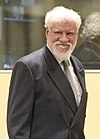 |
Another death, albeit a far less sympathy-inducing one than #6. The convicted war criminal demonstrated a flair for the dramatic as he took his own life in The Hague. "O true apothecary, thy drugs are quick" indeed. | |
| 9 | Deaths in 2017 | 749,088 |  |
Given the presence of multiple deceased people in the top 10, one cannot be surprised that the list makes its way onto the report again. | |
| 10 | Avengers: Infinity War | 727,183 | The first trailer for the upcoming superhero extravaganza dropped to much hooplah. Everyone knows that you must stay until the credits are over in all MCU films, which will be hard given that all of Hollywood seems to be starring in this one. |
Exclusions
- These lists excludes the Wikipedia main page, non-article pages (such as redlinks), and anomalous entries (such as DDoS attacks or likely automated views). Since mobile view data became available to the Report in October 2014, we exclude articles that have almost no mobile views (5–6% or less) or almost all mobile views (94–95% or more) because they are very likely to be automated views based on our experience and research of the issue. Please feel free to discuss any removal on the Top 25 Report talk page if you wish.
Here's What's Missing
During this holiday season, perhaps you want to come up with an expensive and long list of items that will make your life complete and also get other people to pay for them. I am so pure of heart, that I only want to see the sum of knowledge expanded and perfected. So my short list contains:
- newest and most expensive laptop ever made with 10 USB ports and a CD player
- dictation software
- a manual on using AWB
- but most of all I want to see these new Wikipedias appear in the Wikimedia Incubator.
Furbish only consists of a few verbal swatches but if you use really hard and complicated arithmetic you will understand that there are a billion possible combination of these simple Furbish phrases. The potential for creating complicated literary works is certainly possible. The total lexicon follows:
- wee-tah-kah-loo-loo: Tell me a joke.
- wee-tah-kah-wee-loo: Tell me a story.
- wee-tee-kah-wah-tee: Sing me a song.
- u-nye-loo-lay-doo?: Do you want to play?
- u-nye-ay-tay-doo?: Are you hungry?
- u-nye-boh-doo?: How are you?
- u-nye-way-loh-nee-way: Go to sleep now.
- u-nye-noh-lah: Show me a dance.
- doo?: What? (Furbies say this when called)
- doo-d: Yes. (Furbies say this in response to a command before doing it)
- boo: No. (Furbies say this when they do not want to carry out a command)
- yoo?: Why will you not play with me today? (This usually means the Furby is upset)
Newsflash - as this article was going to press, I was encouraged to find that the Furbies have their own Wikipedia called WikiFur.

Klingon Wikipedia In 2005 the Klingon Wikipedia was a reality (it was moved to Wikia in 2006), and a written character from that language was even included in the famous puzzle-piece Wikipedia logo. But since you only want to learn enough Klingon to order a bottle of water you can begin your studies here:
jIyajbe’.- Do you speak Klingon?Dochvetlh vISoplaHbe’.- I don’t understand.bIlughbe’.- I can’t eat that thing.bortaS bIr jablu’DI’ reH QaQqu’ nay’.- You are wrong.jIl moH ghajjaj jaghHomlIj.- Revenge is a dish best served cold. (lit: When cold revenge is served, the dish is always very good)romuluSngan Hol yIjatlh. He’So’ QIchlIj.- May your rival have an ugly neighbor.mo’Dajvo’ pa’wIjDaq je narghpu’ He’So’bogh SajlIj.- If I use spit (mouth water) to clean your father’s honor, I only dirty the spit.qajunpaQHeylIjmo’ batlh DuSuvqang charghwI’ ’It.- Your stinking pet has escaped from its cage and appeared in my quarters.nobwI’’a’pu’qoqvam’e’ nuHegh’eghrupqa’moHlaHbe’law’lI’neS SeH’eghtaHghach’a’na’chajmo’.- Because of your apparent audacity the depressed conqueror is willing to fight you.be’HomDu’na’wIjtIq’a’Du’na’vaD ghureghqangqa’moHlaHqu’be’taH’a’ Somraw’a’meyna’wIj’e’?- The so-called great benefactors are seemingly unable to cause us to prepare to resume honorable suicide (in progress) due to their definite self control.

Porky Pedia This w-w-w-w-w-wikipedia has its beginning with a cartoon character who was so excited he could barely get out his words. Here are the few phrases that are documented: "Th-th-th-that's all folks!" and "What's guh-guh-guh-guh—...what's happening?" "Oh, son of a bi-bi-, son of a bi-bi-, son of a bi-bi-bi-... gun!"

Yodapedia The language of Stars Wars' most beloved character (who began his career as a puppet and later morphed into a CGI personality), is a form of another linguistic language based upon anastrophe. The speech patterns of Yodish have been analyzed and discussed by academic syntacticians, who found it somewhat inconsistent, but could extrapolate that it has Object–subject–verb word order.
Pig Latin It is certainly feasible to build a bot (the Swedes did it, don't you know) to translate all Wikipedia articles into Pig Latin. You know that nothing brings more joy to a sixth-grader than being fluent in Pig Latin. But after about ten minutes of listening to the child speaking this language you'll eventually get a migraine. Yet mastery has its perks because nothing will earn you more respect with the Kiddies that to throw some Pig Latin around the house. Parents sometimes resort to this language in desperation when they don't want the three-year old to know that he or she is going to get a shot at the pediatrician's office that day. English vulgarities lose their punch when translated into Pig Latin.
If-fay ou-yay an-kay ead-ray is-they, en-thay onsider-kay ourself-yay ooent-flay in-nay Ig-pay Atin-lay. If-fay anyone-ay wants-way to-tay leave-lay a message-may below-bay in-nay any-ay of-ay ese-thay afore-ay mentioned-may new-nay anguage-lay Ikipedias-way, av-hay a goh-gay.
Attribution: Some content was cut and pasted from articles related to the above topics. Those other editors did the real work.


























